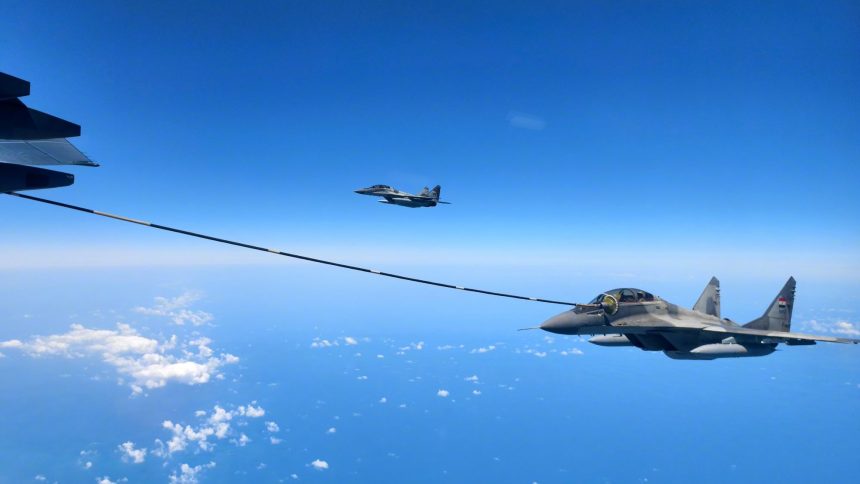The scale of the exercise, diversity of aircraft involved and mission sets practiced were unusual for the first ever exercise between the two air forces.
The 18-day ‘Eagles of Civilization 2025’ aerial drills between China and Egypt, which ran from Apr. 19 to May 4, 2025, saw the PLA Air Force’s YU-20/YY-20A tankers refueling Egyptian Air Force (EAF) MiG-29M/M2s, among other advanced maneuvers. A Z-20 tactical utility helicopter, is also seen in the new visuals from the Chinese military media wings on CGTN, CCTV 7 and Global Times.
Diverse mission sets were reported as part of the exercise, as well as a variety of aircraft. These missions included “suppressive air defense” for “air superiority” as the “basis for all air and ground operations”; interoperability displayed through the Y-20 refueling the MiG-29; formation/display flying; and “battlefield search and rescue.”
The scale and the variety of aircraft and missions were described as unusual for maiden aerial drills between the two countries. The exercise also culminated in a symbolic flypast over the pyramids in Giza on May 1.
Journey to the West over the snow capped Karakorams 🏔️
6x J10AS/C + 1x KJ500 + Z-20KA/S + Y20s for the EOC-2025 https://t.co/7QbMGgZ4Ve pic.twitter.com/BRZT1OB28y
— Húrin (@Hurin92) May 5, 2025
It is unclear if the exercise also featured a live-fire component, although, in the officially released media, all aircraft were flying clean without any weapons stores. Also, it is not known if the refueling missions with the Y-20s and the MiG-29s were a one-off or were practiced regularly during the drills.
Also, it must be noted that, except for the MiG-29s receiving fuel from the YU-20/YY-20 and some shots from flypasts, joint formation flying and ground operations, neither country released visuals that directly captured the aircraft during the drills.
This exercise lasted 18 days, pretty long
China also brought 1 KJ-500 & Z20KS (foldable + fit in Y20)
Also practiced refueling w/ Egyptian Mig-29
PLAAF was showcasing how it does combat to Egyptians, including likely satellite ISR
Also showed it can bring emergency supply anytime… https://t.co/fKQjBf1IW8 pic.twitter.com/2DNOYrAtCr
— tphuang (@tphuang) May 5, 2025
Participating aircraft
The PLAAF deployed four to five Y-20A tankers that were also tracked live between Apr. 13 to 15, some of them flying along the 6,000 km route between China Himalayan southwest bordering India with hops to Dubai. A KJ-500 AEW&C aircraft and a Y-20 were captured by a satellite on Apr. 17.
The latest images showed the Z-20 helicopter, as well as visuals of six J-10s (two twin-seat J-10AS and four J-10Cs) and the YU-20/YY-20A tanker (tail number 11550) during the flight to Egypt over the Karakoram mountains late in April. This brings the Chinese contingent to nine aircraft. The Z-20 was carried in one of the four-five Y-20 transporters that shuttled between the two countries.
The YU-20/YY-20A refueler was also identified by leading Chinese military aviation researcher Andreas Rupprecht as the first airframe within the PLAAF’s 4th Transport Division. Over the Karakorams, the YU-20 is shown with both the underwing refueling hoses extended and some the J-10s flying behind it, implying all the six J-10s were refueled throughout the single-leg journey.
The KJ-500 AEW&C however could not be seen in these images of the trip to Egypt. CGTN footage also showed a close up of the right-side underwing pod, with a small Ram Air Turbine (RAT) rotating on its nose.
The PLAAF contingent transiting the Karakoram Mountains while en route to the bilateral exercise hosted by Egypt. pic.twitter.com/9tczURPsDq
— Shahryar Pasandideh (@shahpas) May 5, 2025
Aerial refueling and other drills
The Y-20 has a three-point hose-and-drogue refueling system, which includes two underwing pods and one centerline arrangement. The EAF jets appear to be refueled using YU-20’s underwing pods only. Another small clip from a J-10 cockpit did show a night-time contact with a YU-20.
Military analyst Shahryar Pasandideh noted the EAF’s MiG-29Ms carrying a buddy refueling pod, “which is decidedly sub-optimal for land-based fighters.” Specifically, this is the PAZ-MK fuel pod, which reports say was also used in the past by two MiG-29Ms to refuel two EAF Rafales during the Qader-2020 exercise.
The Z-20, which may have participated in the “battlefield search and rescue” scenario, was not captured in images that emerged initially when the drills kicked off. Earlier claims that Beijing was transferring J-10s bought by EAF also turned out to be false, as it now emerged the Y-20s carried a large load of equipment and personnel.
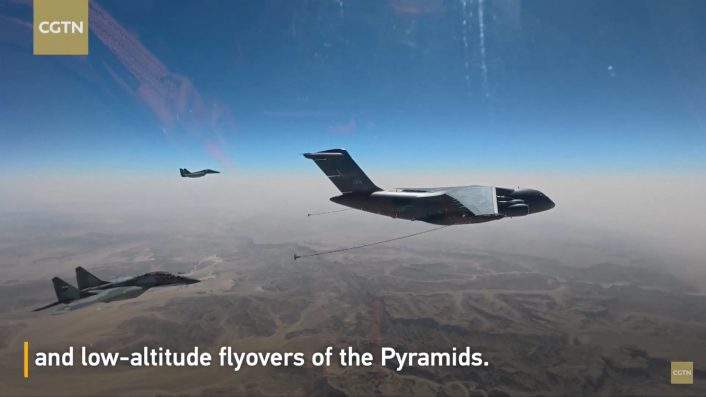
Chinese goals
A debut exercise with the full-range of small, large, basic and advanced, long-duration maneuvers is not possible without willing diplomatic alignment discreetly laying the groundwork. For one, the 18-day drills kicked off on Apr. 19, 2025, within three days of Beijing’s announcement on Apr. 16, and concluded on May 4, true to the “early May” deadline.
The massive Y-20 ferries and the satellite image showing the KJ-500 AEW&C aircraft and another Y-20 at Wadi Abu Rish indicated large, advanced, complex maneuvers from which the announcement from China’s Ministry of National Defense (MND) pulled the veil of secrecy early on with its Apr. 16, 2025 announcement.
Subsequent visuals of the aircraft flying and taxiing together demonstrated there never was anything ‘secret’ or ‘alarming’ about the drills. The only prominent feature was how maneuvers with such sheer scale, complexity and duration were pulled off in the first installment.
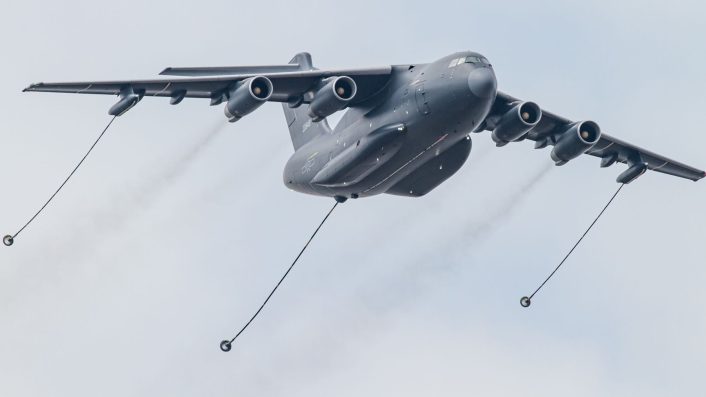
“This joint training marked the first time the PLA Air Force has deployed a systematic force to Africa for such exercises,” Chinese reports quoted the PLA Air Force. The PLAAF demonstrated both “long-range deployment” and “agile operations” capability by conducting “equipment setup, theoretical instruction, mission planning, and command coordination […] swiftly […] upon arrival.”
This enabled “systematic rapid force projection” by “supporting the agile deployment of aerial combat systems, providing valuable experience for deepening future combat-oriented training,” PLA’s Li Bokuan said in the short news featured on GT.
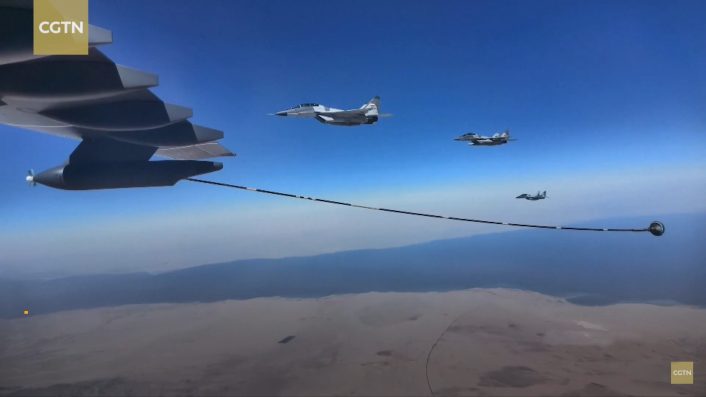
GT earlier quoted military expert Wang Yunfei, who pointed to how the large long-distance maneuvering showed the PLA Air Force’s ability and “adaptability […] to operate far from home,” and in “diverse environments.” In its latest report, GT quoted Wang Ya’nan, chief editor of Beijing-based Aerospace Knowledge magazine, pointing to the PLAAF’s “heavy equipment transport capability,” with the Y-20 carrying the Z-20 helicopter “over thousands of kilometers.”
Geopolitical significance
From a geopolitical standpoint, this exercise marks the tectonic diplomatic realignments triggered by a rising China and a retreating U.S., taking the New Great Power Contest, tellingly, to Africa – which also bore the brunt of the last one. Operations like air superiority, SEAD/DEAD, “suppression of hostile systems” to enable “all air and ground operations […] demonstrated a high-level of collaboration,” between the two air forces, and a “new starting point and significant milestone in the military cooperation.”
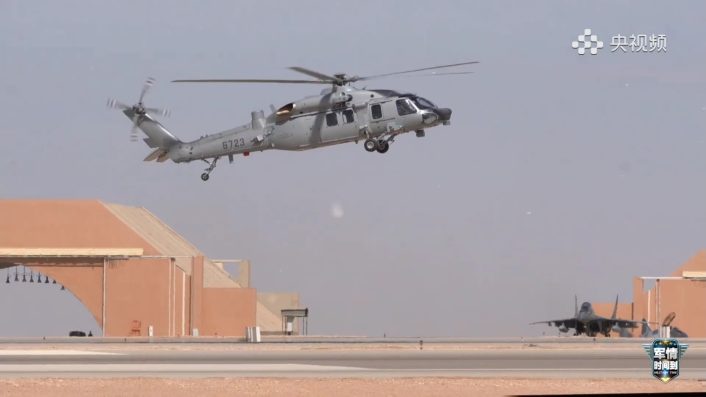
This also came at a time “when Egypt is looking to upgrade its combat equipment,” Wang added. Additionally, it demonstrated both the J-10’s capability and the Y-20’s compatibility with Russian-origin equipment used by many developing-countries.

